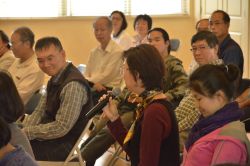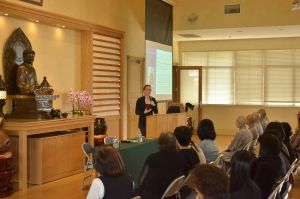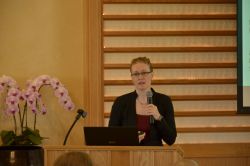Buddhism in Japan-From local Experiment to Systematic Movement

In this lecture, Dr. Jessica Main addressed the state of contemporary Buddhism in Japan and compared her views with other scholars who have written books on this subject.
Presently, three sects of Buddhism exist in Japan – Zen, Pureland and Lotus School of Buddhism.
These sects are structured with a few head temples, each having a network branching in smaller temples. The temples in the lower hierarchy pay up to the head temples which in turn, organize resources for their temples downstream. In recent years, this network has atrophied and Buddhism is currently in a state of crisis in Japan.

Temples of these sects are usually located in rural Japan. With the exodus of people from rural areas to cities, less and less people are going to the temples; temples have become less important in people's lives. In the past, temples also relied heavily on activities related to their forests and farmlands for income. Unfortunately, the farmland reform in 1946 took away forests and farmlands from temples, preventing temples from earning income from these activities involving their lands. Performing funerals is now the main source of income for these local temples.

John K. Nelson's “Experimental Buddhism”, “Contemporary Take for Contemporary Japan” and Jonathan S. Watts' “This Precious Life” discuss about progressive and experimental Buddhism in modern day Japan.
Nelson and Watts mentioned the random and creative activities that temples are undertaking in efforts to engage people and bring them back into the temples. In addition to traditional activities, concerts, symposiums, fashion shows and even cafes and pubs serving alcohol can be found in temples. This form of “experimental Buddhism” is the temples' attempt to make Buddhism relevant to the Japanese society and people’s life.

From the 1920's to 1945, prewar Buddhism innovation took place through social action and many Buddhists supported the government in charitable activities such as disaster relief, building bridges, roads, hospitals and houses. After losing World War II and experiencing US occupation, very few immediate postwar Buddhist innovations occurred in social action because the actions of these temples were discouraged and invalidated as a result of losing the war; momentum and support of the temples waned.
Challenges and opportunities exist for Buddhism in Japan. The challenges are to create a grassroots experience, overcome secularism, systematize and institutionalize Buddhist efforts in the areas such as chaplaincy and suicide. Opportunities are to discover prewar history and change social attitudes directed towards visibly Buddhist individuals and practices.

In conclusion, for a more accurate take on the state of contemporary Japanese Buddhism, we must first examine the entire Buddhist development to include and go beyond the local temple and temple priest. Secondly, rediscover prewar history of the social work and action of the Buddhist temples, and learn from those successful experiences. A new door may be wide open.
Presented by Dr. Jessica L. Main
Dharma Drum Vancouver Center on July 25, 2015
Summarized by Daphne Tsai